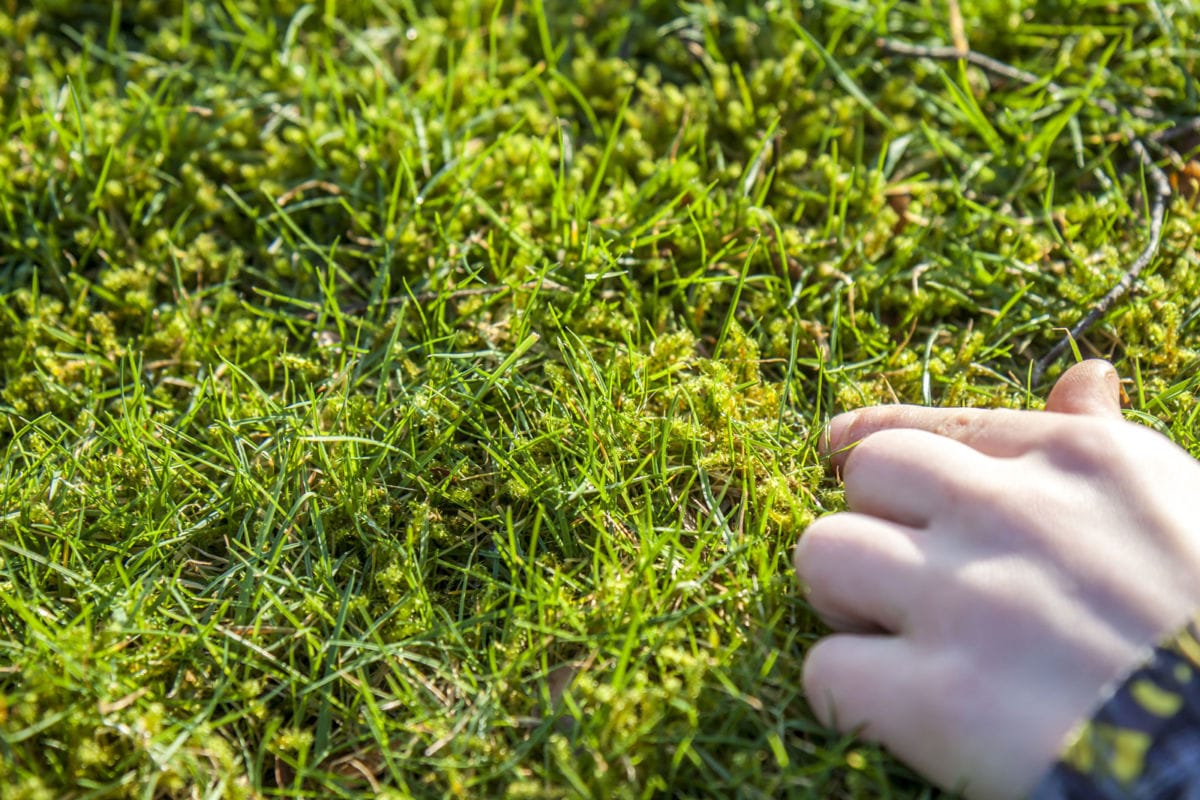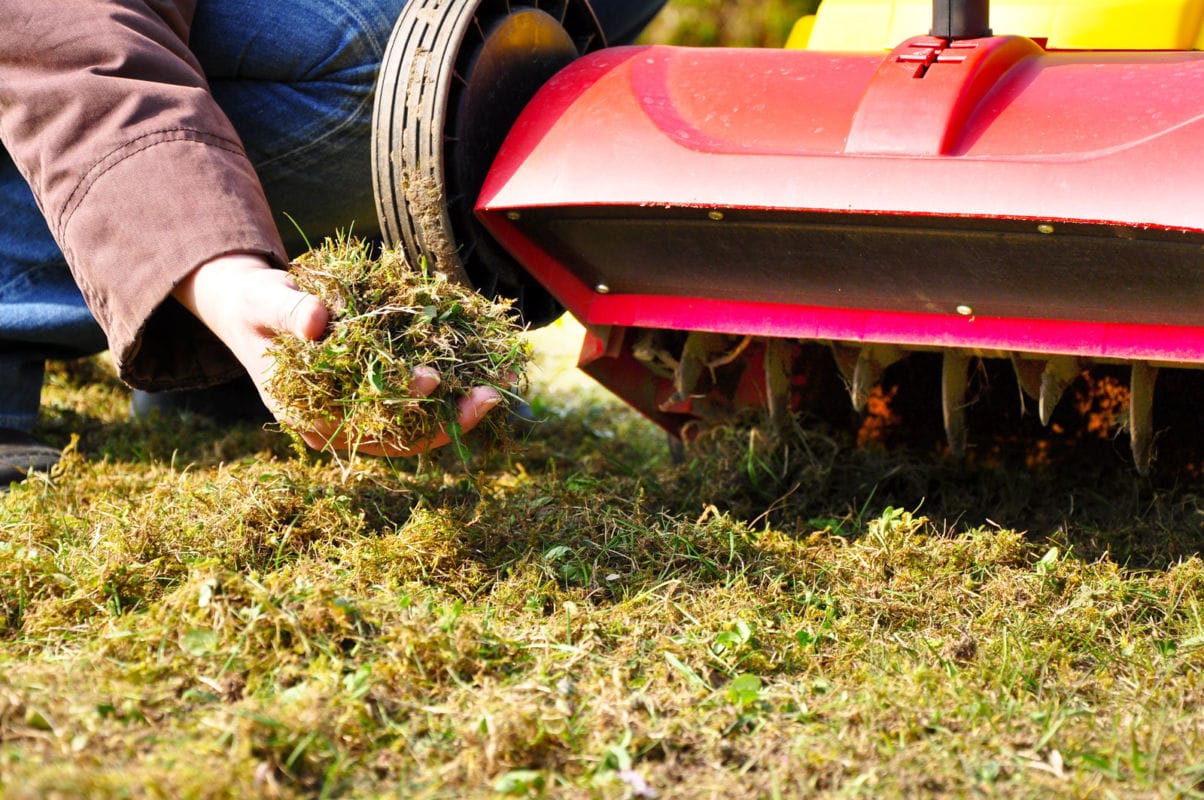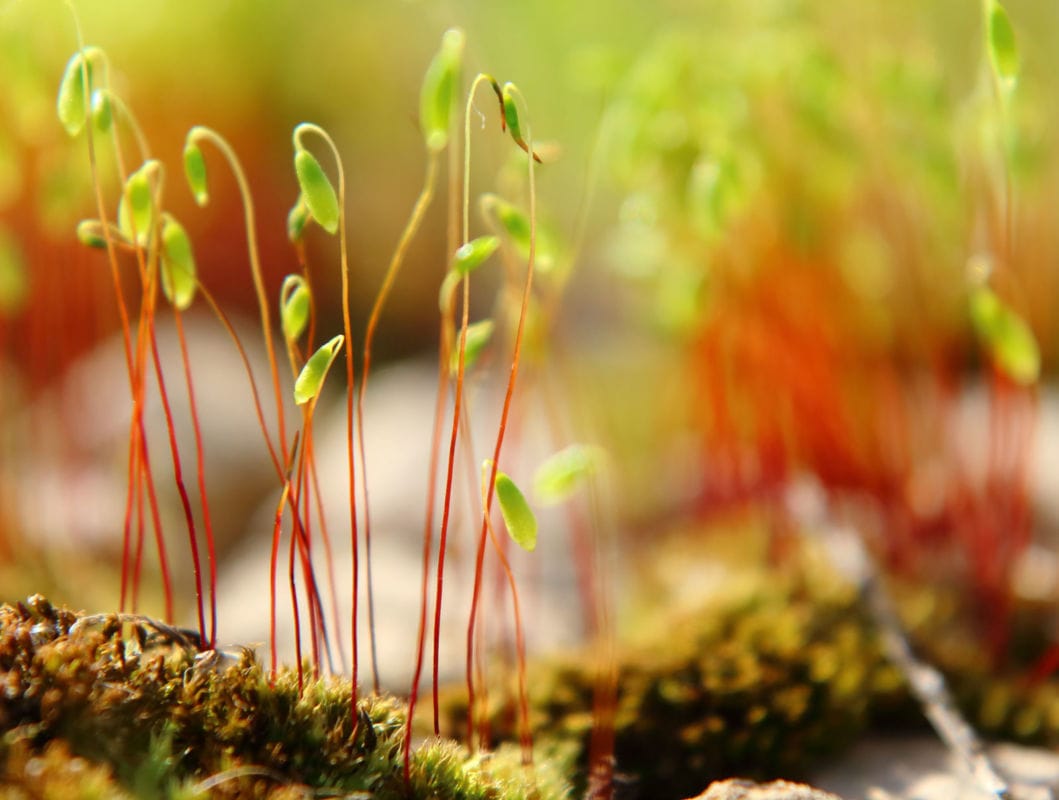One of the things I’m asked most often is “What’s the best way to get rid of moss?” Here are my top tips for controlling moss in lawns.
- Understand your enemy – learn all you can about the likes and dislikes and the life cycle of moss
- Create growing conditions that moss doesn’t like
- Keep your grass healthy so that it can ward off all invaders
- Scarify at least once a year
- Aerate to relieve soil compaction and address drainage issues
- Apply lawn treatments regularly – even if you can’t see any moss
Understand your enemy – more about moss
I’m sure I don’t need to describe moss to you – you know what it looks like and you know the effect it can have on your lawn. In fact, I’m guessing that if you are reading this article, you already have a moss problem and you want to know how to address it.

Typically, a mossy lawn feels spongy to walk on, has a thin sward of weak, pale grass and doesn’t cope well with wear and tear
Knowing how moss behaves and what conditions it thrives in, is key to tackling this lawn invader. So please take time to read this section before moving on to the bit about how to get rid of it.
Moss is a primitive plant. It doesn’t behave in the same way as other lawn weeds such as dandelions or plantain. And that means it needs a different management approach.
Most of the plants in your garden have internal structures called phloem and xylem which transport water and nutrients from the roots and around the leaves. A bit like our arteries and veins. Moss doesn’t have those structures. Instead, it absorbs water through the surface of its leaves and its rhizoids. A rhizoid is a root-like structure that anchors the moss plant to the soil. Water and nutrients then travel from cell to cell via capillary action.
That explains why moss thrives best in a damp environment. It simply can’t grow its roots to access soil moisture. Moss also likes shade – presumably because the soil dries out quicker when its in full sun.
How moss reproduces
When it comes to reproduction, this simple plant is actually quite complicated. It will have 2 generations living side by side in the same colony. Each one is very different. The first, the Gametophyte generation, has male and female plants. Sperm from the male plants, swims through water (or is carried in splashes of rain) to the egg in the female plant. The two combine to form an embryo.
The embryo develops into the second generation plant – called a Sporophyte. Sporophytes grow little tiny stalks which have a structure on the end which is full of spores. You can often see the stalks but the spores within them are microscopic. Spores are released and get carried on the wind to where they hope to find a suitable place to develop into a gametophyte.
So there you have it. You don’t need to remember all the details or the scientific names. But these are the important facts.
- Moss needs water to survive and reproduce
- There are two stages in the life cycle of moss – your job is to interrupt reproduction in both stages
- Moss spores are invisible to the naked eye but it’s fair to assume that they’re always present. Your job is to stop them becoming plants.
- Spores can remain dormant for many years – moss control is a long-term challenge.
- Spores can blow in from outside of your garden
How to get rid of moss in your lawn

Scarification lifts moss and dead or weak vegetation out of your lawn – I’m always surprised at just how much debris can accumulate in the course of a year.
Getting rid of moss in a lawn involves 3 stages.
- Get rid of the moss you can see
- Manage your lawn so that the growing conditions don’t suit moss
- Keep treating your lawn so that the reproductive cycle of moss is constantly interrupted.
Removing visible moss
I have a two step system for removing visible moss. First, I scarify. Scarifying is essentially using a rake to comb all of the moss out from between the grass blades. There is an art to it though. If you get the timing wrong, or if you are too rough with the rake, you can harm the grass.
It’s possible to scarify using a spring tine rake. I wouldn’t recommend it for anything other than a postage stamp sized lawn though. It’s hard work and it takes a long time.
Instead, you can either hire a scarifier from your tool hire shop, or you can delegate the job to a lawn care professional like me.
Scarifying will also remove the thatch layer in a lawn, improving the air flow around the plants and giving them more room to grow. Thatch is an accumulation of dead grass and other debris which slows down water absorption and traps microorganisms such as the microscopic fungi that cause lawn diseases. And – yup, you guessed it moss spores.
I like to apply moss treatments such as Iron Sulphate AFTER scarification and aeration to tackle any little bits of moss that the scarifier has missed. It’s a far more economical and efficient use of the treatment.
Creating the wrong growing conditions for moss
Most of the art of lawn care centres around creating the perfect growing conditions for grass. Luckily for us, these are also the least favourite conditions for moss.
Grass likes good drainage. Moss likes to have plenty of water around. Grass likes sunshine, Moss likes shade.
Start your moss control in early winter by cutting back trees and shrubs that are casting shade on your lawn. If parts of your lawn are in perpetual shade – you might want to tweak your garden layout. Perhaps create a border for shade loving plants instead. Alternatively, get ready to overseed the area with shade tolerant grass seed and give this area lots of TLC. I’ll blog about shaded lawns very soon.
By cutting back trees and shrubs, you are not only decreasing shade, you are increasing air flow. Which should mean that your lawn will dry out quicker after rainfall or watering.
With the shade tackled. It’s time to address drainage.
Lawns are a gardener’s very best tool for getting rid of excess rainwater. They soak it all up and let it filter down to underground aquifers and from there to streams and rivers. However, when a lawn is full of thatch and growing on compacted soil, it takes longer to drain. Thus creating the perfect conditions for moss.
Once you have scarified your lawn, I recommend that you aerate it. Aeration is simply the action of creating small holes in the surface of the lawn that will make it easier for water to penetrate the soil. It also helps get more air to the roots so that they can grow faster and work more efficiently.
For spring and autumn lawn renovations, use a hollow time aerator to remove little plugs of soil.
Again, you can either aerate by hand, using a proprietary tool, or you can rent a mechanical aerator. Even better – you can hire a lawn care professional to do the work.
Rake all of the little plugs off your lawn when you’ve finished and stand back to admire your work.
Interrupting the life cycle of moss

These are Sporangium, the fruiting bodies formed during the Sporophyte phase of the moss lifecycle. Each one contains thousands of microscopic spores that will be taken by the wind to establish new colonies wherever they land.
Immediately after scarification and aeration your lawn will probably look very sorry for itself. There’ll be baldy bits, more soil than you want to see and it’ll generally look a bit battered. Don’t worry, it’ll soon recover.
This is the time to apply a good feed (Be sure to use the right formulation for the time of year) and a tonic. The feed will encourage your grass plants to grow fast and fill in any bare bits of soil before moss can populate them. Depending on the weather, it may take a couple of weeks for you to see the effects of a lawn feed kicking in.
Lawn tonics are very good for pepping up grass plants very quickly indeed. Most of them also contain the mineral Iron – which is very good at zapping moss.
So, if you are are aiming to get rid of moss in your lawn, lawn tonic is your friend. Apply it after scarification and aeration to help the lawn recover. And also 3-4 times throughout the year to interrupt the growing cycle of any moss spores that are nestling in the sward.
If your lawn is very bald after getting rid of moss, you can overseed it to thicken up the sward. Read my blog on choosing the right seed for the job – I’ll post a link at the end of the article.
Need help getting rid of moss?
Premier Lawns offers services to help people in and around Belfast to achieve their dream lawns. But, if you live a little further afield, we can still help. Subscribe to our YouTube Channel for weekly lawn care demonstrations and tips so that you too can have the lawn of your dreams.
More useful articles
How soil compaction affects your lawn and what you can do about it
How to get and maintain a beautiful lawn
